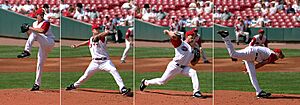Pitch (baseball) facts for kids
In baseball, a pitch is when a player throws the baseball towards home plate. This starts the game! The word "pitch" comes from old rules. Back then, players had to throw the ball underhand, like tossing horseshoes. Throwing overhand wasn't allowed until 1884.
Scientists have studied how pitchers throw. A throw has many steps: the windup, cocking (getting ready), acceleration (speeding up), deceleration (slowing down), and follow-through.
Pitchers throw many different kinds of pitches. Each pitch has its own speed, path, and movement. Pitchers also change how they hold the ball, their wrist position, and arm angle. These changes are meant to trick the batter. They help the defense get the batter or base runners out. To make the ball move differently, the pitcher changes their grip when they release the ball. This makes the seams "catch" the air in unique ways. This changes the ball's path, making it harder for the batter to hit.
Choosing which pitch to throw depends on many things. These include the type of batter, if there are any runners on base, how many outs there are, and the current score of the game.
Contents
Signaling Pitches
In the past, the catcher usually chose the pitch. They would use hand signals to tell the pitcher. One finger might mean a fastball, or the pitcher's best pitch. The pitcher could shake their head if they wanted a different choice.
Today, the manager or a coach often chooses the pitch. They send secret hand signals to the catcher. This stops the other team from knowing what pitch is coming next. Starting pitchers usually throw more pitches than relief pitchers.
Fastballs
The fastball is the most common pitch in baseball. Most pitchers can throw some type of fastball. Many pitchers throw a four-seam fastball. It is thrown very fast, usually as hard as the pitcher can throw while keeping control. Some fastballs move or "break," while others go straight and fast. Good throwing form is important for fastballs. It helps the ball go as fast as possible, making it hard for the batter to hit.
Some fastballs, like the cut fastball or split-finger fastball, have extra movement. They are sometimes called "sinking-fastballs" because of how they drop.
Here are some common fastball pitches:
- Cutter
- Four-seam fastball
- Sinker
- Split-finger fastball
- Two-seam fastball
Rising Fastball
A "rising fastball" is a term for a fastball that seems to drop slower than it should. When a pitcher puts backspin on a fastball, it pushes against gravity. More backspin means the ball "rises" more, or drops slower.
Breaking Balls
Well-thrown breaking balls move, usually sideways or downwards. A ball "moves" because of changes in the air pressure around it. This happens because of how the ball spins. The ball then follows the path of least resistance, which keeps changing. For example, a slider thrown by a right-handed pitcher spins in a way that creates lower air pressure on the pitcher's left side. This makes the ball "slide" to the left from the pitcher's view. The main goal is to make the ball hard to hit or to confuse batters. Most breaking balls are considered off-speed pitches.
Here are some common breaking pitches:
- 12–6 curveball
- Curveball
- Knuckle curve
- Screwball
- Slider
- Slurve
Changeups
The changeup is a key off-speed pitch. It looks like a fastball when thrown but arrives much slower at the plate. Its slower speed and tricky delivery are meant to mess up the batter's timing. It's thrown like a fastball, but held deeper in the hand. This makes it leave the hand slower but still look like a fastball.
A changeup is usually 8–15 miles per hour slower than a fastball. If thrown well, it confuses the batter. The human eye often can't tell the ball is slower until it's very close to the plate. For example, a batter might swing as if it's a 90 mph fastball, but it's only 75 mph. This makes them swing too early, which is why the changeup is so effective.
Here are some common changeups:
- Circle changeup
- Forkball
- Fosh
- Palmball
- Straight changeup
- Vulcan changeup
Other Pitches
Some other pitches used in baseball include:
- Gyroball
- Shuuto
- Junk pitches like the Eephus pitch and Knuckleball.
- Illegal pitches are pitches that break the rules, like adding a sticky substance to the ball. Examples include the Spitball.
Pitching Deliveries
The most common way to throw a pitch is the "three-quarters delivery." Other ways include the submarine (underhand) and the sidearm deliveries. There is also a crossfire technique, which works only for sidearm throws.
A pickoff move is how a pitcher throws to a base to try and get a runner out.
Pitching Positions
There are two legal ways a pitcher can stand:
- The windup
- The set, also called the "stretch"
Pitchers using the set position often use a high leg kick. They can also release the ball faster by using the slide step.
Images for kids
See also
 In Spanish: Lanzamiento (béisbol) para niños
In Spanish: Lanzamiento (béisbol) para niños




